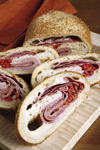
The diversity of Italy’s 20 regions is reflected in its food from the earthy truffles of Umbria to the salty, sea-soaked squid and tiny sardines found in the waters off the Sicilian coast. Today, thanks to an abundance of Italian food products available in the United States, it is possible to experience these regional culinary treasures without leaving town. Italian food aficionados can find their favorite salumi (the collective term in Italian for cured meats), cheeses, pesto, olives and pasta, at their local delis, independent groceries and large supermarket chains.
Prisco’s Fine Foods in Aurora, Ill., is one of those stores.
Owner Robert Prisco sells a variety of ethnic foods, but Italian tops the list of customer favorites. He sells homemade items like marinated artichokes and mushrooms, veal and beef meatballs with tomato sauce, and sweet and hot Italian sausages. Prisco says that sales from his sausages alone account for nearly 2 percent of his total sales, especially at Christmastime and in the summer. “Italian food is my heritage. Our store is known for its great Italian food at affordable prices,” says Prisco.
His grandparents Mary and Tony Prisco, both Italian immigrants, opened shop on the ground floor of their home in 1926, catering to a population homesick for familiar foods. Today Prisco’s is a full-blown grocery store with a deli area and salad bar. Lunch and dinner specials include the Big Tony (an Italian sandwich stuffed with pepperoni and salami on home-baked Italian torpedo rolls), ricotta stuffed shells, and Caprese salad made with tomato, basil and mozzarella. The owner makes its own pizza dough, plus pasta dishes like lasagna, and suggests that deli owners help customers understand the many ways Italian food can be prepared. And Prisco practices what he preaches: He offers customers cooking advice and even shares his own recipes — how to fry Italian peppers, prepare veal parmigiana or spinach pasta with gorgonzola, for example. “We want to provide consumer education and teach our customers how to make delicious Italian food,” he says.
Prisco’s also cultivates a loyal customer base by selling cherished Italian favorites like tiramisu, cannolis, biscotti and spumoni. The coffee and gelato shop he operates next door is a place where patrons can sip strong espresso or a frothy cappuccino while indulging in a homemade gelati or sorbetti. As Robert says, “You can get everything you need for an Italian lunch or dinner.”
The Italian-food Phenomenon
The recently updated “Italian Foods in the U.S.” survey from Packaged Facts reports that sales for Italian food reached $11.9 billion in 2006, growing 3 percent over the 2005 level of $11.5 billion. Sales are projected to top nearly $14 billion by 2011, the survey says.
Add the fact that Zagat’s 2008 Restaurant Survey ranked Italian cuisine as America’s favorite ethnic fare, and you have a recipe for success for delis that merchandise and market Italian products.
The most successful delis sell a range of regional Italian products, but sales of Italian meats (Genoa salami, mortadella, proscuitto cotto and sopressata) and cheeses (provolone, pecorino, and parmesan) are the mainstay of the Italian food market in the United States per AP.
Supermarkets like Trader Joe’s and Whole Foods, for example, offer a bounty of Italian selections. Ready-to-bake artesian pizzas topped with mozzarella, sausage, roasted peppers and pesto, and high-end, pre-made pasta such as gorgonzola-stuffed tortellini are just two examples. At some Whole Foods locations, shoppers can buy portioned, pre-made pizza dough, along with small bags of sliced pepperoni and freshly shredded Mozzarella cheese to take and make their own pizzas. The ingredients are displayed in the same case as the ready-to-bake pies.
Old-school Italian in the heart of New York
Perhaps nowhere is Italian food more appreciated that in New York City’s Little Italy. While the neighborhood is smaller than in its heyday, the spirit inside Di Palo Fine Foods remains strong. Siblings Lou (Luigi), Salvatore and Marie Di Palo — the fourth generation of Di Palos to bring Italian food to New York — took over the store when their father, Sam (Savino), retired. Today, Di Palo’s is a neighborhood institution, drawing regulars and tourists, alike. “We are one of the last original families left in the neighborhood,” Lou Di Palo says.
Di Palo’s sells 300 regional varieties of cheese (some 100 kinds of pecorino, plus homemade ricotta and mozzarella), as well as quality meats and hard-to-find specialties from all 20 regions of Italy. Trips to Italy several times a year help the family foster special relationships with local Italian producers. “We want people to understand our Italian heritage through our foods. We use food to bring Italy to America,” Lou Di Palo explains.
In a nod to the importance of cross-merchandising, customers can also learn about Italian wine by visiting the authentic Italian enotecca next door, where Lou Di Palo’s son, Sam sells Italian wine and spirits, like amaro (bitters), grappa and limoncello. And while all delis can’t add liquor-based products, they can merchandise items like pastas, olive oils, Italian bread and olives near their Italian meat and cheese offerings to create a complete Old World shopping experience in the deli area.
Attesting to the unwavering popularity of Italian cuisine, the Di Palo family plans to expand their breadbox-sized store to accommodate crowds and provide more delicious regional delights later this year.
“Some of our customers call Di Palo’s the 21st region of Italy,” Lou Di Palo says.
